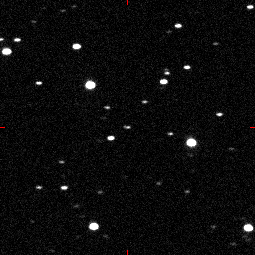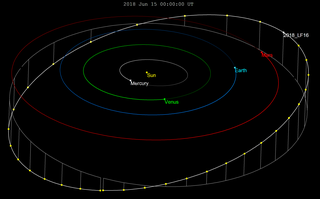Related Research Articles

(29075) 1950 DA, provisional designation 1950 DA, is a risk-listed asteroid, classified as a near-Earth object and potentially hazardous asteroid of the Apollo group, approximately 1.1 kilometers in diameter. It once had the highest known probability of impacting Earth. In 2002, it had the highest Palermo rating with a value of 0.17 for a possible collision in 2880. Since that time, the estimated risk has been updated several times. In December 2015, the odds of an Earth impact were revised to 1 in 8,300 (0.012%) with a Palermo rating of −1.42. As of 2022, It is listed on the Sentry Risk Table with the second highest cumulative Palermo rating of −2.05. 1950 DA is not assigned a Torino scale rating, because the 2880 date is over 100 years in the future.

2004 FH is a micro-asteroid and near-Earth object of the Aten group, approximately 30 meters in diameter, that passed just 43,000 km (27,000 mi) above the Earth's surface on 18 March 2004, at 22:08 UTC. It was the 11th closest approach to Earth recorded as of 21 November 2008. The asteroid was first observed on 16 March 2004, by astronomers of the Lincoln Near-Earth Asteroid Research at the Lincoln Laboratory's Experimental Test Site near Socorro, New Mexico.
(433953) 1997 XR2 is a sub-kilometer sized asteroid, classified as near-Earth object and potentially hazardous asteroid of the Apollo group. It was discovered on 4 December 1997, by the Lincoln Near-Earth Asteroid Research (LINEAR) program at Lincoln Laboratory's Experimental Test Site near Socorro, New Mexico, in the United States.
(292220) 2006 SU49, provisional designation 2006 SU49, is a sub-kilometer asteroid, classified as near-Earth object and potentially hazardous asteroid of the Apollo group that had a small chance of impacting Earth in 2029.
(179806) 2002 TD66 (also written 2002 TD66) is a sub-kilometer asteroid, classified as near-Earth object of the Apollo group. It was discovered on 5 October 2002, by the LINEAR project at Lincoln Laboratory's ETS in Socorro, New Mexico. It was announced on 7 October 2002 and appeared later that day on the JPL current risk page.

2010 TD54 is a tiny asteroid and fast rotator, classified as a near-Earth object of the Apollo group, approximately 5 meters in diameter. It was first observed by the Mount Lemmon Survey in October 2010, when the asteroid crossed through the Earth-moon system and had a close encounter with Earth.
(471240) 2011 BT15, provisional designation 2011 BT15, is a stony, sub-kilometer sized asteroid and fast rotator, classified as a near-Earth object and potentially hazardous asteroid of the Apollo group. It had been one of the objects with the highest impact threat on the Palermo Technical Impact Hazard Scale.
2012 KP24 (also written 2012 KP24) is a Chelyabinsk-sized near-Earth asteroid with an observation arc of only 5 days and has a modestly determined orbit for an object of its size. Around 31 May 2023 ±3 days it will pass between 0.19–24 lunar distances (73,000–9,200,000 km) from Earth. Nominally the asteroid is expected to pass 0.026 AU (3,900,000 km; 10 LD) from Earth and brighten to around apparent magnitude 21.6.
2008 AO112 (also written 2008 AO112) is an Apollo near-Earth asteroid and potentially hazardous object. It was discovered on 12 January 2008 by the Mount Lemmon Survey at an apparent magnitude of 21 using a 1.5-meter (59 in) reflecting telescope. The asteroid was quickly lost and had an estimated diameter of 310 meters (1,020 ft). On 25 June 2009, with an observation arc of only 1 day in January 2008, the asteroid had a 1 in 4 million chance of impacting Earth on that very day. The virtual impactor had not been eliminated from the Sentry Risk Table by the day of the potential impact.

2010 JL88 is an unnumbered asteroid, classified as a near-Earth object of the Apollo group, approximately 19 meters in diameter. It was first observed by the Siding Spring Survey, Australia, on 15 May 2010. It is known to be the fastest rotator with an unambiguous period solution, having an exceptionally rapid rotation period of less than 25 seconds.
2009 RR micro-asteroid, classified as near-Earth object of the Apollo group. It was discovered on 11 September 2009 by the Catalina Sky Survey at an apparent magnitude of 19.5 using a 0.68-meter (27 in) Schmidt–Cassegrain telescope. 2009 RR was the only asteroid discovered before 2014 that was predicted to potentially pass inside the orbit of the Moon during 2014. The asteroid has an estimated diameter of 26 meters (85 ft) and is listed on the Sentry Risk Table. It is not large enough to qualify as a potentially hazardous object.
2011 XC2 (also written 2011 XC2) is a near-Earth asteroid roughly 60–140 meters (200–460 ft) in diameter that passed less than 1 lunar distance from Earth on 3 December 2011.

2014 RC is a sub-kilometer near-Earth object and Apollo asteroid. The exceptionally fast rotator passed within 0.000267 AU (39,900 km; 24,800 mi) (0.1 lunar distances) of Earth on 7 September 2014. The asteroid is approximately the diameter of the Chelyabinsk meteor, and passed almost as close to Earth as 367943 Duende (2012 DA14) did in 2013.
2014 SC324 is a sub-kilometer asteroid and fast rotator, classified as a near-Earth object of the Apollo group, approximately 50 meters in diameter. It was first observed on 30 September 2014, by the Mount Lemmon Survey at an apparent magnitude of 21 using a 1.5-meter (59 in) reflecting telescope. With an absolute magnitude of 24.3, the asteroid is about 37–85 meters in diameter.
2012 FN is an Apollo asteroid and a near-Earth object that has a 1 in 4 billion chance of impacting Earth on 7 March 2113. It is estimated to be 5 meters in diameter, which means that it poses no threat if it impacts Earth. An impact would have the kinetic energy of about 3 kt of TNT, and would probably result in an air burst in the upper atmosphere. It is the least threatening asteroid listed on the Sentry Risk Table. The very short observation arc of only 3 hours results in a very poorly constrained orbit, and it could just as easily be 2 AU from Earth on 7 March 2113.
2015 AZ43 (also written 2015 AZ43) is an Apollo near-Earth asteroid roughly 70 meters in diameter. On 10 February 2015 with a 29.5-day observation arc, it showed a 1 in 5,880 chance of impacting Earth on 27 February 2107. However, the NEODyS nominal best-fit orbit shows that 2015 AZ43 will be 2.8 AU (420,000,000 km; 260,000,000 mi) from Earth on 27 February 2107. A (non-impacting) Earth close approach in 2056 makes future trajectories diverge. It was removed from the JPL Sentry Risk Table on 23 February 2015 using JPL solution 26 with an observation arc of 40 days that included radar data.
2012 TV is a near-Earth Apollo asteroid with an estimated diameter of 30 metres (98 ft). Its closest approach to the Earth was on October 7, 2012 with a distance of 0.0017 astronomical units. It also approached the Moon an hour earlier with a distance of 0.0028 astronomical units. With a short observation arc of 1.8 days, the asteroid is listed on the Sentry Risk Table and has a 1:500,000 chance of impacting Earth on April 2, 2081.

2018 LF16 is a small Mars crossing asteroid roughly 213 m (699 ft) in diameter. It was first observed by astronomers with the Pan-STARRS survey at Haleakala Observatory on 14 June 2018. It was removed from the Sentry Risk Table on 29 July 2021. With an observation arc of 15 years the orbit is very well known and it does not make any notable approaches to Earth.
2019 SU3 is a very small near-Earth asteroid of the Apollo group, first observed by the Asteroid Terrestrial-impact Last Alert System at Haleakala Observatory on 23 September 2019. It was briefly listed on the Risk List of the European Space Agency. With a 18-day observation arc, the nominal orbit passes 0.02 AU (3,000,000 km; 1,900,000 mi) from Earth on 27 September 2084. It was removed from the Sentry Risk Table on 12 October 2019.
2020 HS7 is a very small asteroid classified as a near-Earth object of the Earth-crossing Apollo group. When it was discovered by the Pan-STARRS 2 survey on 27 April 2020, the asteroid was initially calculated to have a 10% chance of impact with Earth before being ruled out by improved orbit determinations from additional observations. Although there is now no risk of impact with Earth, it did make a close approach 42,700 kilometres (26,500 mi) from Earth on 28 April 2020, with a flyby speed of 15.6 kilometres per second (9.7 mi/s) relative to Earth. The asteroid will not make any close encounters within 1 lunar distance (380,000 km; 240,000 mi) of Earth in the next 100 years.
References
- 1 2 3 4 "JPL Small-Body Database Browser: (2008 HJ)" (last observation: 2008-04-30; arc: 6 days; uncertainty: 6). Jet Propulsion Laboratory . Retrieved 30 March 2016.
- ↑ Record spin for new-found asteroid, BBC.com, 30 May 2008
- ↑ "Earth Impact Risk Summary: 2008 HJ". NASA/JPL Near-Earth Object Program Office. Retrieved 22 January 2018.